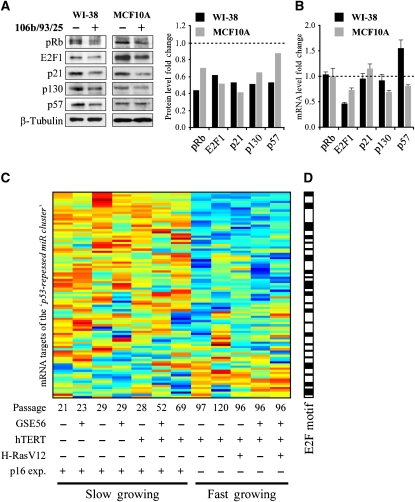Figure 6.
Overexpression of miR-106b/93/25 polycistron results in silencing of cell-cycle-related genes. WI-38 primary fibroblasts and MCF10A mammary cells were infected with a retrovirus encoding for either the genomic region that contains miRs-106b/93/25 or an empty vector control. (A) Western blot analysis of cell-cycle-regulating targets of the overexpressed miRs. Overexpression of miRs-106b/93/25 reduced the protein levels of E2F1, pRb, p130, E2F1 and p21 in both cell types and of p57 in WI-38 cells. β-Tubulin levels serve as a loading control. The scanned blots were analyzed using the ImageJ software. Values represent the fold change of each protein relative to the empty vector-infected cells, and were normalized to the levels of β-tubulin. (B) QRT–PCR analysis of the mRNA levels of the genes presented in (A). Values represent the fold change of each mRNA relative to the empty vector-infected cells. Data are represented as mean±s.d. (C) Expression pattern of predicted targets of at least five miRs from the ‘p53-repressed miR cluster.' mRNA expression levels were derived from WI-38 cells that underwent immortalization and gradual in vitro transformation (the cell status is indicated below) as described by Milyavsky et al (2003). This expression pattern was found to be significantly coherent (EC score=0.14, EC P-value=5 × 10−3). See Supplementary dataset S4 for the expression values. (D) Promoter analysis performed on the genes from (C) (using AMADEUS) revealed enrichment for E2F motif (P-value=2.2 × 10−13). Genes with E2F motif in their promoter are indicated in black in the bar on the right (and in Supplementary dataset S4).

